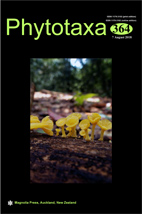Abstract
The foliar architecture of 18 genera (Barkleyanthus, Digitacalia, Erechtites, Nelsonianthus, Packera, Pentacalia, Pippenalia, Pittocaulon, Psacaliopsis, Psacalium, Pseudogynoxys, Robinsonecio, Roldana, Senecio, Telanthophora, Tetradymia, Villasenoria and Werneria) of the tribe Senecioneae (Asteraceae) distributed in Mexico is described. The aim was to identify leaf characters to be used in the taxonomy and phylogenetics of the tribe, as well as a source to identify at the generic rank the genera distributed in Mexico. More than 400 specimens were revised and several leaves were cleared to analyze leaf venation patterns. Four patterns of primary venation (actinodromous suprabasal, paralelodromous, pinnate and radiate-palmate) and five patterns of secondary venation (brochidodromous, weak-brochidodromous, craspedodromous, mixed-craspedodromous and festooned-semi-craspedodromous) were identified. Terminal tracheids were observed only in veinlets of Pentacalia, Pseudogynoxys and Werneria. In addition, secretory canals and crystals occurred in several genera. Foliar architecture showed to be a useful tool to identify genera, an identification key based mostly on leaf architecture characters is provided.

